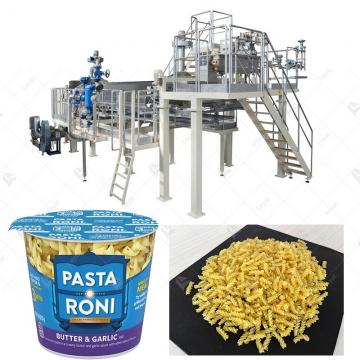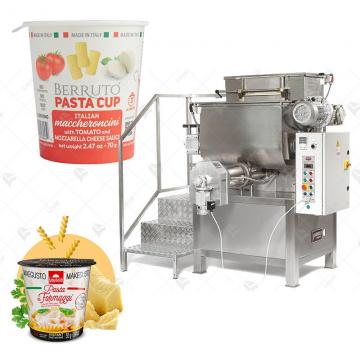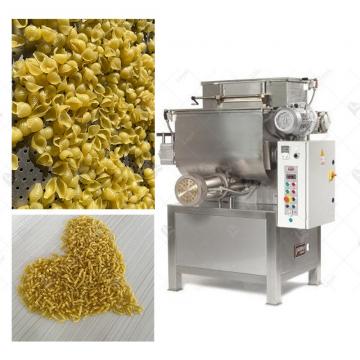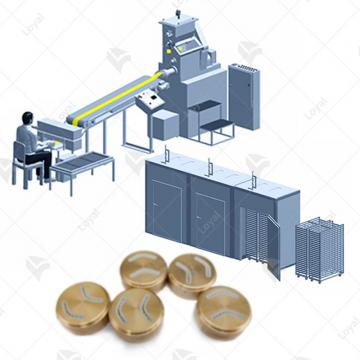
- Shandong Loyal Industrial Co.,Ltd.
- SHORT-CUT PASTA PRODUCTION LINE LONG-CUT PASTA PRODUCTION LINE INSTANT PASTA PRODUCTION LINE
Home> Company News> The Ultimate Guide To Macaroni Pasta Production Line In 2024

The Ultimate Guide To Macaroni Pasta Production Line In 2024
2024-03-28 11:33:32A macaroni pasta production line encompasses a series of interconnected machinery and processes designed to transform raw ingredients into finished macaroni pasta products. The significance of these production lines cannot be overstated, as they streamline the manufacturing process, minimize human error, and ensure product uniformity.
The macaroni pasta production line represents an integrated system of machinery and processes dedicated to the mass production of macaroni pasta. It encompasses various stages, from mixing raw ingredients to packaging the final product, with a focus on efficiency and consistency.In the food industry, the macaroni pasta production line plays a pivotal role by streamlining production processes, maximizing output, and ensuring uniform quality. Its significance lies in meeting the ever-growing demand for pasta products while adhering to strict standards of taste, texture, and hygiene.
Importance and Scope of Macaroni Pasta Production Line in 2024
In 2024, the macaroni pasta production line holds paramount importance in the food industry due to its pivotal role in meeting the escalating global demand for pasta products. With consumer preferences continually evolving towards convenience and quality, the production line serves as the backbone of efficiency and consistency in delivering macaroni pasta to markets worldwide.
The scope of the macaroni pasta production line extends beyond mere manufacturing; it encompasses innovation, sustainability, and adaptability to emerging trends. In an era marked by technological advancements and environmental consciousness, production lines in 2024 are expected to integrate cutting-edge technologies for enhanced automation, precision, and resource optimization. Furthermore, they must align with sustainable practices, minimizing waste and energy consumption while meeting stringent quality standards.
As consumer palates diversify and dietary preferences evolve, the scope of the macaroni pasta production line in 2024 also encompasses versatility. Production lines must be equipped to accommodate a wide array of pasta varieties, shapes, and ingredients, catering to niche markets and dietary requirements. By embracing innovation, sustainability, and versatility, the macaroni pasta production line in 2024 transcends its traditional role, becoming a symbol of excellence and adaptation in the ever-changing landscape of the food industry.
Overview of Machinery and Equipment
1. Raw Material Handling
The journey begins with the handling of raw materials. Robust conveyors transport the primary ingredients, such as durum wheat flour, water, and additives, to the mixing stage. Here, precise measurements ensure the perfect composition for macaroni dough.
2. Mixing and Kneading
In this phase, the ingredients undergo thorough mixing and kneading. High-capacity mixers blend the components to form a homogeneous dough. This stage is critical for achieving the desired texture and consistency of the macaroni.
3. Extrusion
The extrusion process molds the dough into its iconic macaroni shape. Extruders equipped with custom dies carefully shape the dough, imparting the classic twists and curves associated with macaroni pasta.
4. Drying
Drying is a crucial step in macaroni pasta production, as it removes excess moisture and enhances shelf life. Sophisticated dryers utilize controlled temperatures and airflow to achieve uniform drying without compromising quality.
5. Cutting and Shaping
Once dried, the pasta undergoes precision cutting and shaping. Cutting machines equipped with razor-sharp blades ensure consistent lengths, while shaping tools impart distinctive features to different types of macaroni.
6. Sorting and Inspection
Quality control is paramount in macaroni pasta production. Automated sorting and inspection systems meticulously scrutinize each piece, detecting any imperfections or irregularities and ensuring only the highest-quality pasta reaches the packaging stage.
7. Packaging
Efficient packaging is essential for preserving the freshness and integrity of the macaroni. Advanced packaging machinery carefully seals the pasta in airtight containers, pouches, or boxes, ready for distribution to consumers worldwide.
8. Automation and Control Systems
Central to the macaroni pasta production line is its sophisticated automation and control systems. These cutting-edge technologies optimize efficiency, minimize waste, and ensure seamless operation throughout the manufacturing process.
9. Cleaning and Sanitation
Maintaining hygiene standards is paramount in food production. Dedicated cleaning and sanitation equipment thoroughly sanitize the production line, preventing contamination and safeguarding consumer health.
10. Maintenance and Servicing
Regular maintenance and servicing are essential to prolonging the lifespan of the macaroni pasta production line. Skilled technicians conduct routine inspections and repairs, minimizing downtime and maximizing productivity.
Operational Processes and Best Practices in Macaroni Pasta Production Line
The macaroni pasta production line integrates advanced technologies and precise methodologies to ensure efficiency and consistency in every step of the process. Let's explore the key components of this intricate system.
1.Recipe Formulation and Ingredient Handling
Macaroni pasta production line starts with meticulous recipe formulation, where the proportions of flour, water, and other ingredients are carefully calibrated to achieve the desired texture and taste. Each ingredient, from durum wheat semolina to water, undergoes stringent quality checks to maintain the highest standards.
2.Dough Preparation
Macaroni pasta production line begins with the preparation of dough, where the ingredients are mixed to form a homogeneous mixture. The dough undergoes conditioning to optimize its elasticity and consistency, crucial for the extrusion process.
3,Extrusion Techniques for Macaroni Shapes
Extrusion is a pivotal stage in the macaroni pasta production line, where the dough is pushed through specialized dies to create distinctive macaroni shapes. Advanced extrusion techniques ensure precise shaping, with the equipment meticulously maintained to guarantee uniformity across batches.
4.Heat Transfer Mechanisms
Drying is a critical phase in the macaroni pasta production line, where moisture is removed to enhance shelf life and prevent microbial growth. Heat transfer mechanisms, including convection and radiation, are employed to accelerate the drying process while preserving the integrity of the macaroni.
5.Quality Assurance during Drying
Quality assurance measures are paramount during drying, with stringent monitoring of temperature and humidity levels to prevent over-drying or uneven moisture content. Automated systems and sensors ensure consistency, while manual inspections provide an additional layer of quality control.
6.Packaging Materials and Methods
Packaging is the final stage in the macaroni pasta production line, where the macaroni is carefully sealed to maintain freshness and prevent contamination. High-quality packaging materials, such as laminates and barrier films, are utilized to safeguard the product during transit and storage.
7.Shelf-life Management and Storage Conditions
Shelf-life management is crucial in the macaroni pasta production line, with optimal storage conditions essential to preserve quality. Controlled environments, free from moisture and temperature fluctuations, prolong the shelf life of macaroni, ensuring it reaches consumers in peak condition.
Importance of Quality Control in Pasta Manufacturing
Quality control stands as the cornerstone of pasta manufacturing, ensuring that each step of the production process adheres to rigorous standards to deliver superior products to consumers. In the bustling world of pasta production, where efficiency and consistency are paramount, quality control plays a pivotal role in upholding the reputation of brands and satisfying the discerning palates of customers.
Raw Material Selection:The journey of crafting delectable pasta begins with the careful selection of raw materials. Quality control measures are implemented to scrutinize the quality and purity of ingredients such as durum wheat semolina, water, and sometimes eggs. By sourcing only the finest ingredients and conducting thorough inspections, manufacturers can lay a solid foundation for the production of premium pasta products.
Production Process Monitoring:Throughout the various stages of pasta production, from mixing and extrusion to drying and packaging, quality control mechanisms are in place to monitor every aspect of the process. Advanced technology, including sensors and automated systems, enables real-time monitoring of parameters such as dough consistency, temperature, and drying time. Any deviations from the established norms trigger immediate corrective actions, ensuring that the final product meets stringent quality standards.
Consistency in Pasta Shapes and Sizes:One of the hallmarks of quality pasta is uniformity in shapes and sizes. With the aid of precision-engineered machinery such as pasta extruders and cutters, manufacturers can maintain consistency in the dimensions and textures of pasta products. Regular calibrations and inspections of equipment guarantee the accuracy of shaping and cutting, resulting in visually appealing pasta that cooks evenly and retains its shape upon cooking.
Texture and Taste Evaluation:The texture and taste of pasta are critical factors that contribute to the overall dining experience. Quality control protocols include sensory evaluations conducted by trained professionals to assess the firmness, chewiness, and flavor profile of the pasta. By conducting sensory tests at various stages of production, manufacturers can identify any deviations from the desired attributes and make necessary adjustments to preserve the sensory qualities that consumers crave.
Packaging Integrity:The final stage of pasta manufacturing involves packaging the products for distribution and sale. Quality control measures extend to packaging integrity, ensuring that the packaging materials meet food safety standards and provide adequate protection against external factors such as moisture and contamination. Through rigorous testing and inspection of packaging materials and sealing techniques, manufacturers can safeguard the freshness and quality of the pasta until it reaches the hands of consumers.
Compliance with Regulatory Standards:In addition to meeting internal quality standards, pasta manufacturers must also comply with stringent regulatory requirements set forth by governing bodies. Quality control processes encompass regular audits and inspections to ensure compliance with food safety regulations, labeling requirements, and hygiene standards. By adhering to these regulations, manufacturers demonstrate their commitment to producing safe and wholesome pasta products that meet the expectations of consumers and regulatory authorities alike.
Compliance with Food Safety Standards and Regulations
In the competitive landscape of food production, ensuring Compliance with Food Safety Standards and Regulations is paramount, especially in the context of macaroni pasta production lines, dry pasta production lines, and pasta macaroni making machines. These machines are designed and manufactured with meticulous attention to detail, incorporating advanced technology to streamline the production process while maintaining the highest standards of hygiene and safety. From raw material handling to shaping, drying, and packaging, every step is carefully monitored and controlled to meet or exceed industry regulations. Manufacturers prioritize the use of food-grade materials and employ rigorous quality control measures to safeguard the integrity of the final product, providing peace of mind to both producers and consumers alike.
Macaroni Pasta Production Line Current Market Landscape in 2024
In 2024, the market for macaroni pasta production lines is witnessing a significant surge in demand, driven by the growing popularity of pasta products worldwide. The macaroni pasta production line is a crucial component of the pasta manufacturing process, enabling efficient and large-scale production. Dry pasta production lines have become increasingly sophisticated, integrating advanced technologies to enhance productivity and product quality. Manufacturers are investing in state-of-the-art machinery and equipment to streamline operations and meet the escalating consumer demand for pasta products.
One of the key players in the industry is the pasta macaroni making machine, which plays a pivotal role in shaping the final product's characteristics. These machines are designed to extrude, shape, and dry pasta dough into various forms, including macaroni, spaghetti, and penne, among others.The current market landscape reflects a growing preference for automated macaroni pasta production lines that offer high efficiency and precision in manufacturing processes. This trend is driven by the need for cost-effective solutions and the desire to minimize manual labor while maximizing output.
Moreover, the emphasis on product innovation and diversification is shaping the competitive dynamics within the industry. Manufacturers are constantly introducing new pasta varieties and flavors to cater to evolving consumer preferences and market trends.In response to increasing environmental concerns, sustainability has emerged as a critical consideration in macaroni pasta production line design and operation. Companies are adopting eco-friendly practices and investing in energy-efficient technologies to reduce their carbon footprint and mitigate environmental impact.The global market for dry pasta production lines is characterized by intense competition and rapid technological advancements. To maintain a competitive edge, manufacturers are focusing on continuous research and development to improve product quality, increase production efficiency, and adapt to changing market demands.
Macaroni Pasta Production Line Emerging Technologies and Innovations
In the realm of food processing, the macaroni pasta production line has witnessed remarkable advancements, driven by innovative technologies. These technologies have revolutionized the efficiency, quality, and sustainability of dry pasta production lines, enabling manufacturers to meet the increasing demands of consumers worldwide.
One pivotal innovation in the pasta macaroni making machine is the integration of automated systems. These systems streamline the entire production process, from raw material handling to packaging, minimizing human intervention while maximizing precision and consistency. By incorporating sensors and artificial intelligence algorithms, these machines can adjust parameters such as moisture content and pasta shape in real-time, ensuring optimal product quality.
Moreover, sustainability has become a focal point in macaroni pasta production. Innovations in energy-efficient machinery and eco-friendly packaging solutions have significantly reduced the environmental footprint of pasta manufacturing. For instance, modern pasta drying technologies utilize heat recovery systems to recycle energy, resulting in substantial cost savings and carbon emission reductions.
Another groundbreaking advancement is the adoption of data analytics and predictive maintenance in dry pasta production lines. By harnessing big data analytics, manufacturers can optimize production schedules, minimize downtime, and preemptively identify potential equipment failures. This proactive approach not only enhances operational efficiency but also prolongs the lifespan of machinery, ultimately lowering maintenance costs.
Furthermore, the emergence of 3D printing technology has revolutionized the design and customization of pasta shapes. Manufacturers can now effortlessly create intricate designs and unique shapes, catering to evolving consumer preferences and culinary trends. This level of customization not only enhances the visual appeal of pasta products but also offers opportunities for branding and product differentiation.
In conclusion, the macaroni pasta production line is experiencing a renaissance propelled by technological advancements and innovations. From automated systems and sustainable practices to data analytics and 3D printing, these technologies are reshaping the landscape of pasta manufacturing. As the industry continues to embrace these innovations, consumers can expect a diverse array of high-quality, customizable pasta products while also contributing to a more sustainable future.
Exploring Growth Opportunities and Challenges in Macaroni Pasta Production Lines
In recent years, the demand for pasta products has been steadily increasing, prompting manufacturers to invest in efficient production lines to meet consumer needs. One such production line gaining prominence is the macaroni pasta production line. This innovative machinery streamlines the manufacturing process, enabling producers to meet the rising demand effectively.
Dry pasta production lines have revolutionized the pasta manufacturing industry by offering increased automation and efficiency. These production lines are equipped with advanced technology, allowing for precise control over the production process. Manufacturers can customize settings to produce various types and shapes of pasta, including macaroni. The versatility of pasta macaroni making machines ensures that producers can adapt to changing consumer preferences swiftly.
Despite the growth opportunities presented by macaroni pasta production lines, there are several challenges that manufacturers must navigate. One such challenge is the initial investment required to procure and set up the production line. While the long-term benefits outweigh the costs, securing funding for the machinery can pose a hurdle for some businesses.
Another challenge is ensuring product quality and consistency. With increased automation comes the need for regular maintenance and calibration to prevent defects in the final product. Additionally, maintaining stringent quality control measures throughout the production process is essential to uphold the brand reputation and meet consumer expectations.
Furthermore, market saturation and competition pose significant challenges for manufacturers entering the industry. As more players invest in dry pasta production lines, differentiation becomes crucial to stand out in the market. Innovation in product offerings, packaging, and marketing strategies can help companies carve a niche and capture market share.
To capitalize on the growth opportunities in the macaroni pasta production line sector, manufacturers must stay abreast of technological advancements and consumer trends. Investing in research and development to create unique pasta varieties and flavors can attract discerning consumers seeking novel culinary experiences.
In conclusion, while macaroni pasta production lines offer promising growth opportunities for manufacturers, they also present challenges that require strategic planning and innovation to overcome. By addressing these challenges and leveraging technological advancements, producers can thrive in the competitive pasta manufacturing industry.
References
1. Food Engineering Magazine (https://www.foodengineeringmag.com/)
2. International Pasta Organisation (IPO)(https://www.internationalpasta.org/)
3. American Association of Cereal Chemists International (AACCI) (https://www.aaccnet.org/)
4. European Food Research and Technology Journal(https://www.springer.com/journal/217)
5. Food Processing Magazine (https://www.foodprocessing.com/)
FAQs: Common Questions About Macaroni Pasta Production Line
Q1: What is the typical process involved in a macaroni pasta production line?
A: A macaroni pasta production line typically involves several key stages, including dough mixing, extrusion, drying, and packaging. During dough mixing, durum wheat flour and water are thoroughly combined to form a homogeneous mixture. The dough is then extruded through a specialized machine to shape it into the characteristic tubular form of macaroni. After extrusion, the macaroni undergoes a drying process to remove excess moisture, ensuring shelf stability. Finally, the dried macaroni is packaged using automated systems, ready for distribution.
Q2: What are the key components of a macaroni pasta production line?
A: The main components of a macaroni pasta production line include a dough mixer, extruder, drying chamber, and packaging system. The dough mixer is responsible for mixing the ingredients to form the pasta dough. The extruder shapes the dough into macaroni tubes. The drying chamber removes moisture from the macaroni to ensure proper shelf life. Finally, the packaging system packages the dried macaroni into various formats for distribution.
Q3: What is the production capacity of a typical macaroni pasta production line?
A: The production capacity of a macaroni pasta production line can vary depending on factors such as the size and configuration of the equipment. However, modern production lines can typically produce anywhere from 500 to 5,000 kilograms of macaroni per hour.
Q4: How can manufacturers ensure the quality and safety of macaroni produced by the production line?
A: Manufacturers employ rigorous quality control measures to ensure the quality and safety of macaroni produced by the production line. This includes testing raw materials, monitoring production processes, and adhering to food safety regulations. Additionally, advanced equipment such as metal detectors and x-ray inspection systems are used to detect and remove any foreign contaminants.
Q5: Is it possible to customize the shape and size of macaroni produced by the production line?
A: Yes, modern macaroni pasta production lines offer flexibility in shaping and sizing options. Advanced extrusion dies and molds allow manufacturers to produce a wide range of macaroni shapes and sizes, catering to consumer preferences and market demands.
 Instant Pasta Production Line
Instant Pasta Production Line INSTANT PASTA CUP PRODUCTION LINE
INSTANT PASTA CUP PRODUCTION LINE PRECOOKED PASTA PRODUCTION LINE
PRECOOKED PASTA PRODUCTION LINE Dry Pasta Production Line
Dry Pasta Production Line